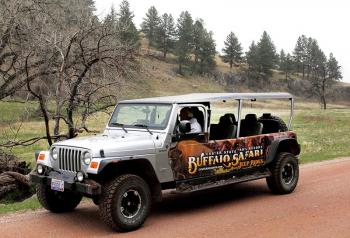
Custer State Park in South Dakota offers jeep rides for wildlife viewing. (Submitted Photo/Courtesy of John K. Flores)
Wildlife viewing in Black Hills is a summer destination
Drawn by the prospects of gold, Lame Johnny was a two-bit horse thief who showed up in the Black Hills of South Dakota during the latter part of the 19th century. Named Cornelius Donahue at the time of his birth in 1850, the rustler moved from Philadelphia to Texas where he learned the finer skills of his criminal trade.
Around the region, Lame Johnny went by the name John A. Hurley, where it’s said he initially tried to live a virtuous life. Later, when recognized by someone who knew him as a horse thief back in Texas, Hurley’s forthright life came to an end, returning him to what he knew best.
How the outlaw became handicapped is not known. Some say he was born with a clubfoot. Others say he may have contracted polio.
Whatever the reason, his limp was easily recognized.
He was also accused of robbing stagecoaches.
But, it was during a raid on the Pine Ridge Indian Reservation, when he was arrested, that Lame Johnny met his demise.
Shackled to the floor of a stagecoach in Chadron, Neb., he was to be returned to Deadwood, S.D, to stand trial.
Unfortunately, Lame Johnny never made it.
Vigilantes stopped the stage and Cornelius Donahue was hanged from an elm tree along what today is known as Lame Johnny Creek near the Black Hills.
Former publisher and editor of the Morgan City Daily Review, Steve Shirley, once said, “We are hyper local,” in a column he wrote expressing the success and newspaper’s unique contribution to the community.
Because of Shirley’s model, I’ve tried to make sure through the years writing this column to keep myself inside the state’s borders.
Moreover, by and large a self-imposed 150-mile radius in sharing the happenings around the state, whether it’s plain old hooks and bullets, nature and bird watching, conservation, or a story about individuals pertaining to outdoor related subjects.
However, nature is where you find it. During a recent trip to the heartland of Nebraska and South Dakota to spring turkey hunt, I found myself captivated by the stories of the old west as told by Custer State Park tour guide Harry Hellon during one of our non-hunting excursions while traveling to the region.
Perhaps only Yellow Stone National Park, because of its sheer size, has more to offer in terms of wildlife viewing.
But, for a couple of Louisianans like my wife and I, Custer had us spellbound, sitting on the edge of our seats wondering what we’d see next.
After seeing herds of free ranging buffalo, antelope, big horn sheep, elk, mule deer, white tailed deer and rocky mountain goats, my comment to Hellon was simply, “It’s a good thing this place doesn’t have the fishing, alligators, and the water we have, because if it did, we’d be hard pressed to keep our status as the Sportsman’s Paradise.”
Indeed, Louisiana has tremendous wildlife viewing and outdoor opportunities that, in my opinion, keep us at the top of the heap.
But, if you’re looking for someplace to take the kids for summer vacation, the Black Hills and Bad Lands of South Dakota should be high on your list.
I chose the town of Keystone as our destination point. Yes, because it’s minutes from Mount Rushmore but also because of Custer State Park. The 72,000-acre park is home to one of the largest free-ranging herds of buffalo in the United States and where scenes of the movie “Dances With Wolves” was filmed.
I wanted to see these big shaggy animals in the environment that the first settlers and great Indian horse culture saw them hundreds of years ago. And I wasn’t disappointed.
Hellon, who is not exactly retired, works at Custer State Park from May to October. Living out of their motor home, he and his wife Joan, who works in the park gift shop, drive up from Texas to spend half the year in the Black Hills.
Hellon drove the jeep we were in so close to buffalo, we could see them blink and hear them grunt, warning us to stay away from their newborn calves — some with umbilical cords still hanging from their bellies.
“We’ve been coming here for the past six years to work and stay in the park and never get tired of seeing the animals — especially these buffalo,” Hellon said between telling stories he knew of settlers, outlaws, and politicians who created Custer State Park. “Once a big male buffalo decided he was going to rest in the driveway where our camper was parked at the campground, blocking the entrance door. There was nothing my wife Joan could do about it. She honked the horn at it, but it just stayed right there until it was ready to leave on its own.”
Lame Johnny Road passes through one of the unimproved roads we drove on to view wildlife. I thought to myself it’s a good thing the outlaw wasn’t living today in those hills we were in, what’s more, was a horse thief and not a car thief.
As the story of Lame Johnny goes those that hanged him wrote on his headboard:
Pilgrim Pause!
You’re standing on the molding clay of Limping John.
Tread lightly stranger, on this sod.
For if he moves you’re robbed, by God.
I’d have hated for Christine and I to have to walk back to the Custer State Park Lodge.
For more information on Custer State Park, visit www.visitcuster.com.
- Log in to post comments
